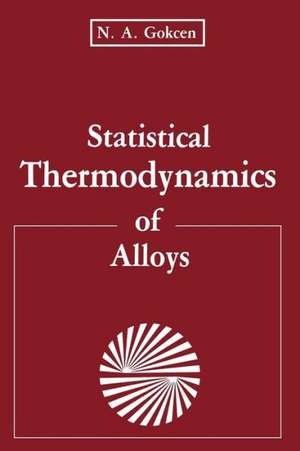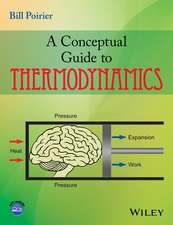Statistical Thermodynamics of Alloys
Autor N.A. Gokcenen Limba Engleză Paperback – 25 noi 2012
Preț: 389.88 lei
Nou
Puncte Express: 585
Preț estimativ în valută:
74.60€ • 77.71$ • 62.19£
74.60€ • 77.71$ • 62.19£
Carte tipărită la comandă
Livrare economică 28 martie-11 aprilie
Preluare comenzi: 021 569.72.76
Specificații
ISBN-13: 9781468450552
ISBN-10: 1468450557
Pagini: 344
Ilustrații: 342 p.
Dimensiuni: 152 x 229 x 18 mm
Greutate: 0.46 kg
Ediția:Softcover reprint of the original 1st ed. 1986
Editura: Springer Us
Colecția Springer
Locul publicării:New York, NY, United States
ISBN-10: 1468450557
Pagini: 344
Ilustrații: 342 p.
Dimensiuni: 152 x 229 x 18 mm
Greutate: 0.46 kg
Ediția:Softcover reprint of the original 1st ed. 1986
Editura: Springer Us
Colecția Springer
Locul publicării:New York, NY, United States
Public țintă
ResearchCuprins
1 Thermodynamic Background.- Consequences of Laws of Thermodynamics.- Helmholtz and Gibbs Energies.- Partial Molar Gibbs Energy.- Activity.- Variation of Activity with Pressure and Temperature.- Depression and Elevation of Freezing Point.- Molar Properties.- Excess Molar Properties.- Analytical Forms of Excess Partial Molar Properties.- Determination of Ge and $$ \overline G _i^e $$ of Ternary Systems.- Interaction Parameters.- Other Definitions of Partial Molar Gibbs Energy.- References.- 2 Phase Equilibria and Phase Diagrams.- Single-Component Equilibria.- Multicomponent Equilibria.- Phase Rule.- Phase Diagrams.- Erroneous Diagrams.- Lever Rule.- Molar Gibbs Energy of Mixing—Phase Diagrams.- ?G Diagrams for Other Phases.- ?G Diagrams for Complex Systems.- Calculation of Phase Diagrams from Thermodynamic Data.- Empirical Rules on Phase Stability.- References.- 3 Statistical Thermodynamics.- Distribution of Independent Particles.- Fermi-Dirac Statistics.- Bose-Einstein Statistics.- Boltzmann Statistics.- Distribution Laws.- Entropy and Related Properties.- Fermions, Bosons, and Boltzons.- Gibbsian Ensembles.- Vibrations of Atoms in Lattices.- Potential Energy Functions.- References.- 4 Theories of Solutions.- Regular Solutions—Zeroth Approximation.- Preliminary Concepts.- Distribution of Molecules.- Equations.- First Approximation.- Approximate Equations.- Dilute Binary Regular Solutions.- Critique of Treatments Based on Permutation of Bonds.- Ternary Regular Solutions.- Regular Associated Solutions.- References.- 5 Long-Range Order.- Ordering and Clustering.- Order-Disorder in Binary Alloys.- Long-Range Order Parameter.- Gorsky, and Bragg and Williams (GBW) Approximation.- Heat Capacity.- More General Cases.- First Approximation.- Enthalpy and Heat Capacity.-Comments on Previous Approximations.- Unequal Numbers of Atoms and Equal Numbers of Sites.- References.- 6 Interstitial Solutions.- Pd-H System.- Statistical Treatment, Zeroth Approximation.- Solid Interstitial Solutes.- Application to Pd-H System.- Other Hydrogen-Metal Systems.- Hydrogen Storage.- Hydrogen Storage Metals and Alloys.- Ti, Zr, Hf and Their Alloys.- Fe-C System.- Wagner Model for Ternary Interstitial Alloys.- Application of Equation (6.106).- Limitations of Wagner Model.- References.- 7 Semiconductors.- Distribution of Electrons.- Motion of Electrons and Holes.- Dopants in Semiconductors.- Energy of Electrons and Holes.- Concentration of Electrons.- Concentration of Holes.- Equilibrium Constant for Charge Carriers.- Correlation of Band-Gap Data.- Derived Thermodynamic Properties.- Ionization Equilibria.- Fermi Energy in Doped Semiconductors.- p-n Junctions.- Effects of Applied Current on p-n Junctions.- Solar Cells.- Simple Equivalent Circuit.- Tandem Solar Cells.- Calculation Procedure.- References.- Appendix A Engel-Brewer Theories.- Basic Principles.- Nonintegral Electronic Configurations.- Transition Elements.- Correlation of Bonding Energies.- Electron Concentration Ranges in Alloys.- Effect of Pressure.- Multicomponent Diagrams.- Concluding Remarks.- Appendix B Estimation of Enthalpy of Alloy Formation.- Empirical Coefficients.- Alloys of Hydrogen.- Ternary Hydrides.- Ternary and Multicomponent Alloys.- Concluding Remarks.- Appendix C Correlation of Thermodynamic Properties in Dilute Solutions.- Appendix D Selected Properties of the Elements.- Appendix E Selected Binary Phase Diagrams and Binary Thermodynamic Properties.- Appendix F List of Symbols.- Appendix G Periodic Table (Mendeleev Table of the Elements).











